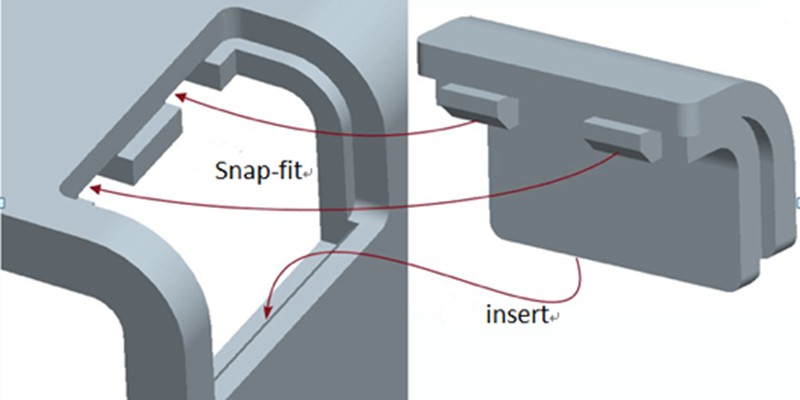- March 24, 2023
Snap fit joints are one of the most common mechanical joint mechanisms found in products all around us. The action of ‘snapping open something’ is usually referring to a snap fit in the background. Tupperware lids, Snap-on bottle caps, and pen lids are all everyday examples of products with snap joints.
This text discusses snap fit joints in detail. We will cover different types of snap fits, the pros and cons of snap fitting, and some interesting tips and tricks for snap fit design.
What is Snap Fitting?
Let us begin with a formal definition of what a snap fit is. A snap fit is a mechanical assemblage where flexible components are joined together. The mating components, typically plastic, have flexible features that are designed to lock each other’s movement when put in a specific relative position. To achieve the fit, one component is pressed into the other one, deforming the flexible features, until they ‘snap’ into their locking positions.
Snap Fit Joints
Snap fit joints are a type of mechanical joint mechanism taking advantage of a snap-fit. They are created by components that can interlock with each other. Moreover, snap fit components do not require additional fasteners to hold them together.
However, their most outstanding feature is that they are reusable. This means that users can assemble and disassemble snap fit joints thousands of times without the mechanism losing its quality. This is generally not the case with other types of fasteners. For example, experts recommend discarding threaded fasteners after a couple of times of use.
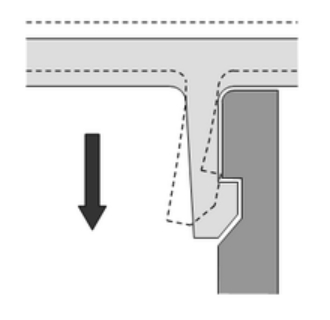
Flexibility is an important material property for snap fitting components as they temporarily deform while snapping on and off. Once the interlocking happens, the components return to their original shape without permanent deformation. Thus, plastics are widely used for manufacturing snap joints due to their flexibility and durability.
Types of Snap Fit Joints
There are various types of snap fit joints with specific applications, benefits, and limitations. In this section, we will explain the main kinds.
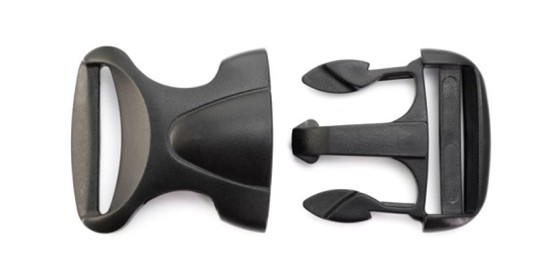
1. Cantilever Snap Fit
Cantilever snap fits are arguably the most common among the various types of snap fits. It includes a cantilever arm with an interlocking feature at its free end. To assemble it, the component with the arm goes into a cavity in the other component, which deforms the arm. Finally, at the end of the cavity, the interlocking feature snaps into place and the arm returns to its original shape.
It is a durable mechanical joint with both temporary and permanent versions. One common issue is the permanent deformation of the cantilever arm. Hyper-extension can cause the arm to lose its capability to return to its original shape or it may even snap off.
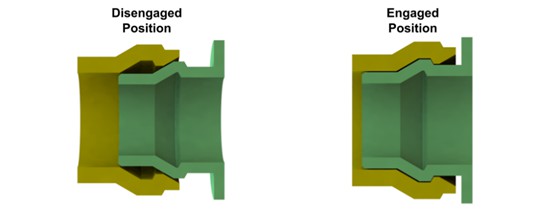
2. Annular Snap Fit
Annular snap fit joints comprise a circular hoop that expands when pushed onto a rigid, matching groove. The expansion causes stress to develop in the annular hoop, generating enough frictional force to hold it on top of the groove structure.
This snap fitting is good for high-stress applications due to the uniform stress distribution in annular shapes. However, there is a chance of hyper-extension and overuse can loosen the snap fit over time as well.
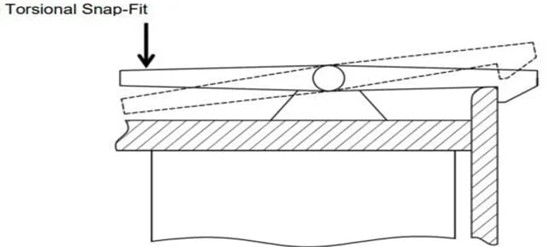
3. Torsion Snap Fit
Torsional snap fits are quite similar to cantilever snap fittings in the sense that they have cantilever arms with clip-like interlocking features. However, the arm stays in position by a torsional force (most often coming from a spring and bearing).
To assemble/disassemble, one must act against the spring force and disengage the interlocking clip. It is a simple joint with less risk of failure and long life.
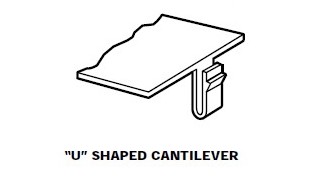
4. U-Shaped Snap Fit
U-shaped snap joints, as the name suggests, have a U-shaped interlocking element. The easiest way of understanding this is to think of a cantilever snap fitting whose arm is half folded onto itself. It works in a similar fashion. The arm bends during assembly/disassembly and the clip interlocks the components.
It is a useful and durable snap fit design. However, it is more prone to hyper-extensions due to multiple stress concentration regions. Moreover, it is not easy to manufacture owing to its geometry.
Benefits of Snap Fit Joints
Snap fit joints have widespread applications across the board owing to the numerous advantages of using them in product design. A short summary of their major benefits is as follows:
Easy Assembly/Disassembly
Unlike most mechanical joints, snap fittings are quite convenient to use. They simply snap on and off in a matter of seconds and do not need special tools (like screwdrivers for screws).
No Extra Hardware
Snap joints are sufficient in themselves to create mechanical joints. There is no requirement for additional hardware such as nuts, washers, screws, etc. to join the components.
Reliable and Long Service Life
If used properly, snap fits can last a lifetime. They have a service life of years and are generally not a contributing factor in rendering a product useless.
Aesthetics
Generally, mechanical fasteners are visible and can make a product look bad. In aerospace products, for example, there are thousands of aerospace fasteners. Snap fits are usually not visible from the outside, preserving the aesthetic design of products.
Limitations for Using Snap Fit Joints
Understandably, a product like snap fittings with so many benefits will also have some limitations. We will discuss these now.
Complex Production Process
The interlocking features and stress concentration regions make the manufacturing of snap fit joints a challenge. Features like locking clips require undercuts in the mold design, which adds complexity and cost. Moreover, since there is a risk of over-extending the joints while ejecting them from their mold, it takes extra care and time.
Easy to Break
Flexible parts are easy to break. The same applies to snap fittings. Although long-lasting, they are prone to breakage under slight over-loading.
Weaker than Permanent Joints
Snap joints are non-permanent joints whose strength is not comparable to that of screws, nuts, and bolts. Although this is not a fair comparison considering snap fit joints have specific applications, it is worth mentioning in our opinion.
Common Issues with Snap Fit Design
Snap fit joints, although long-lasting and efficient, have some common issues that sometimes lead to failure. These are things to take care of when designing and using snap fittings to avoid any issues.
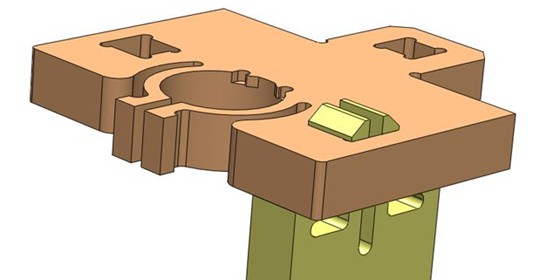
Stress Concentration: Stress concentration refers to the condition where a small portion of the snap fitting is much more heavily loaded than other parts. If the stresses in these areas exceed material strength limits, the structure fails. Stress concentrations are common in snap joints as they are flexible and have curves/turns in their geometry prone to high stresses.
Creep: Creep is a phenomenon where a material gets weak over a long period of time under stress. Since snap fits remain loaded for extensive time periods, they experience creep which can compromise their structural integrity.
Fatigue: Fatigue refers to the weakening of a structure due to cyclic/repetitive loading. Snap fit joints can experience fatigue failure due to frequent assembling/disassembling.
Environmental Conditions: The performance of snap fit joints can deteriorate due to conditions like high temperatures, chemical exposure, and humidity.
Best Tips for Designing Durable Snap Fit Joints
Snap fit design is a challenging field. Engineers need to consider several factors and keep in mind the aforementioned practical issues while designing snap fittings. Design decisions are highly dependent on factors like application, material availability, manufacturability, and budget.
In this section, we provide some expert tips on best practices in snap fit design.
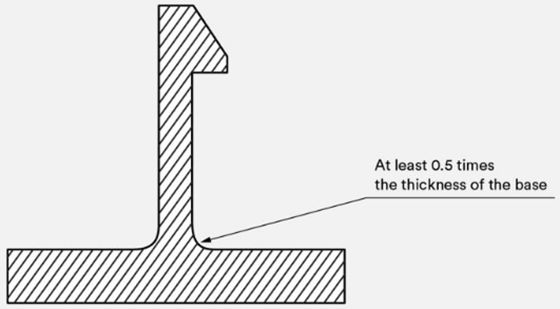
Appropriate Tolerance
Most problems occur due to the mechanical fit between interlocking components being either too high or too low. Tight fits lead to high-stress concentrations and loose fits have insufficient engagement force at the joint interface. A general rule of thumb is to design the joint with a tolerance between interference fits and sliding fits.
Base Fillet at Cantilever Arm
A common practice to reduce stress concentrations is to eliminate the geometric features that cause them. In cantilever joints, these are the sharp corners at the base of the arm. Filleting these corners increases their resistance to stress concentrations.
Wide Clip
The clip is a main component in snap fitting joints, taking a huge portion of the load. A wider clip is stronger. Thus, it is more capable of withstanding stresses.
Stops and Lugs
These are design features that prevent the over-insertion of interlocking components into each other, which causes stress concentrations and hyper-extension. Furthermore, they are also useful in aligning the mating components and sharing their load.
Tapered Design
Adding a slight taper to the snap fit design reduces stress concentrations and material consumption.
Applications of Snap Joints
Snap fit joints have innumerable applications due to their ease of use and utility. We will highlight some of the most common applications.
Snap Fasteners: Snap fasteners are incredibly useful in fitting durable and good-looking parts, they stay hidden from view and create a strong joint.
Pen Caps: Lids on pens are usually an annular snap fit. Users press them on top of the pen, causing them to open up a bit and grip the pen tightly.
Bag Latches: The small snap latches on trekking bags come in handy when they are full and are difficult to manage. These strong snap fit joints are cantilever joints that provide enough strength to contain the contents of the bag.
Tupperware Lids: We all use Tupperware to pack our food. Their lids often come with snap fittings which survive for years without breaking and are strong enough to create air-tight joints.
Conclusion
Snap fit joints are undoubtedly an important part of the product design industry, providing an efficient and convenient method to achieve durable mechanical joints. They are ubiquitous in our surroundings and are definitely something to know about as design engineers.
WayKen is a rapid manufacturing company providing metal and plastic snap fits for your projects. From prototype to part production, our comprehensive services are fully equipped to help you in bringing your ideas to life. Feel free to contact us for expert consultation and quotation.
FAQs
What are snap fit joints?
Snap-fit joints are a type of mechanical joint that uses interlocking features to hold two parts together without the need for additional fasteners or adhesives.
What are the common processes used to produce snap-fit joints?
Injection molding is the most common process used to manufacture snap fit joints. CNC machining and 3D printing are also occasionally used.
What materials can be used for snap fit joints?
The most common material for snap fit joints are plastics like ABS, PETG, Nylon, and PLA due to their flexibility and easiness to mold.
What are the correct tolerances for snap fit design?
There are no hard and fast rules for snap fit design tolerance, but it is recommended to keep it neither too tight nor too loose. A typical range for the gap width is 0.2-0.5 mm, depending upon the type of joint and material used.

